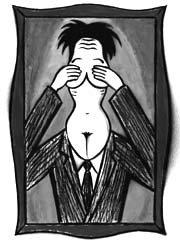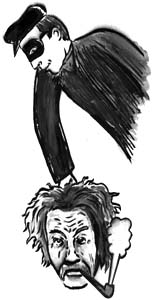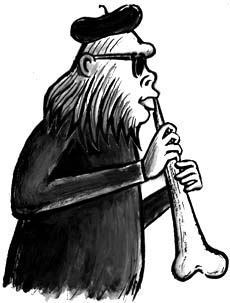News from academe.

Kinsey's Kinky Stuff
Indiana University Press is publishing The Art of Desire: Erotic Treasures From the Kinsey Institute, an exhibition catalog accompanying the first survey of the erotica collected by the institute over the past 50 years. The book, complete with 49 illustrations, follows closely on the heels of James H. Jones' hostile biography of Alfred Kinsey and seems designed, in part, to counter the bad impression left by that book. While the catalog does contain some potentially controversial material, such as Hungarian artist Rezso Merényi's Mouse Kiss, a 1922 etching of "a grand-scale vagina juxtaposed with two mice," the selection, made by the Kinsey Institute itself, mostly highlights the highbrow elements of the collection, such as a Chagall lithograph displaying some mild buttock fondling. In order to "sustain a celebratory tone," write the curators, "representations of certain sexual practices or fantasies (those judged by common consensus pathological) were ruled inappropriate for our overarching agenda." The truly weird stuff can be seen only by appointment. (Here's the Kinsey Institute's Web site.)

It Isn't All Relative
Recent discoveries prove that Albert Einstein was indeed the first to explicate the general theory of relativity. Historians of science have long questioned whether Einstein truly discovered the idea, or whether the honor goes to Göttingen mathematician David Hilbert, who submitted a paper on the subject five days before Einstein turned in his work. Though Einstein's paper was published first, Hilbert maintained that he was the first to have solved some key field equations. Einstein, furious, charged Hilbert with plagiarism. Einstein was right. Hilbert's proofs, found this July at the Max Planck Institute in Berlin, reveal that crucial steps were missing at the time of his submission, which were filled in only after Einstein's paper came out. In an article in Science, the research team that scrutinized the drafts concludes that Hilbert "revised his paper in response to Einstein's work." It's the second big blow to Hilbert's legacy: His audacious attempt to ground all mathematics in a finite number of axioms was upended by Gödel's incompleteness theorem in 1931.
Mine Kampf
A British mining concern has discovered that 1.5 million tons of coal lie buried beneath Newstead Abbey, the family estate of Lord Byron. The company is poised to begin digging on the dilapidated Nottinghamshire property. Byron scholars are concerned that the fragile 800-year-old structure (purchased by the Byron family from Henry VIII in 1540) might collapse if the excavation proceeds. The strongest protests come not from British scholars, however, but from Greek ones. Byron, who led the Greek armed forces in their fight for independence against the Ottoman Turks in 1824, is considered a national hero in Greece. Scholars at the University of Athens are leading the campaign to protect the abbey's romantic ruins. In response, Midlands Mining promises that no harm will come to the abbey, which provided a moody backdrop to both Childe Harold and Don Juan.
Body Conscious
The hot topic at the Modern Language Association meeting this year will be Disability Studies. Scholars in the field decode and debunk the literary tropes that rhetorically separate "normal" from "abnormal" bodies. Essays to be delivered at the conference, which will take place this December in Toronto, include "Oliver Sacks: The P.T. Barnum of the Postmodern World" and "Of Angels and Pig-Faced Ladies: Disordering Victorian Desire." Much as feminists champion The Awakening and lesbian-studies scholars vaunt The Well of Loneliness, disability-studies scholars promise to uncover a slew of founding texts written by the differently abled. One such work is the long-forgotten 1841 memoir A Narrative of the Experience and Sufferings of William Dodd, a Factory Cripple, Written By Himself. A graduate student from the University of California at Irvine will present an analysis of the Londoner's autobiography at the conference.

Early Music
An approximately 50,000-year-old fragment of bear bone, found at an excavated Neanderthal hunting camp in present-day Slovenia in 1995, may be the oldest known musical instrument. It contains four circular punctures that eerily evoke a flute. Paleontologist Ivan Turk, who discovered the bone, recently told Scientific American that the four holes are "really well rounded and just about the right separation for humans to put their finger on." And Bob Fink, a Canadian musicologist, thinks the hole spacing proves that the bone-flute was "inescapably diatonic," suggesting that the eight-tone "Western scale" may be much older than we thought. (His analysis is posted on the Web.) Based on the fragment, Fink speculates that the original flute contained at least six holes and was close to 16 inches long. Not all anthropologists agree. T. Temple Tuttle, an ethnomusicologist at Cleveland State University, feels the holes conform to "a number of scales," including the South Indian system.
The Empire Strikes Back
A book-review editor at Science says she was pressured to retire this past summer after she published a negative review of a book that claimed to defend science from postmodern critiques. The review was of Higher Superstition: The Academic Left and Its Quarrels With Science, written by biologist Paul Gross and mathematician Norman Levitt. The article's author, Smithsonian curator Paul Forman, accused Gross and Levitt of trying to place "science back on its pre-postmodern pedestal." After the review was published, Science received a flood of angry telephone calls and letters, according to the editor in question, Katherine Livingston. (George Mason University's James Trefil, for instance, complained that Forman "gets into material he does not appear to understand. ... You couldn't possibly have published a better parody of what passes for scholarship in the postmodern world.") In an interview with the Chronicle for Higher Education, Levitt took credit for launching the letter-writing campaign: "I was mad as hell that such an irresponsible review had run in Science," he said. After reading the complaints, Science editor in chief Floyd Bloom formally reprimanded Livingston and took away control of the book-review section.
Earth Loses Its Balance
Geologists say that the concept of continental drift may need to be revised to account for some sudden reshufflings that took place in Earth's past. Basing their theories on evidence found in magnetite grains in Australian bedrock, researchers at Caltech posit that 550 million years ago, continents at the poles scooted toward the equator while equatorial continents shimmied to the poles, all within a mere 15 million years. (Typically, a continental shift takes much longer to complete.) What caused the flip-flop? The stability lent by two opposing supercontinents, Gondwanaland and Rodinia, was disrupted when Rodinia began to fracture. Earth's balance was thrown off, and a massive migration was required to regain planetary equanimity. Joseph Kirschvink, a Caltech geophysicist, suggests that this upheaval may have enhanced the workings of evolution. "Each time you disrupt an ecosystem, you break it into small communities, where evolution works fastest," Kirschvink told Discover.